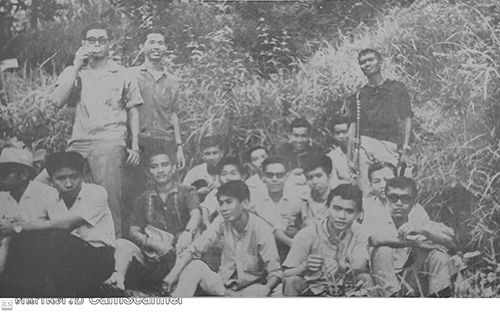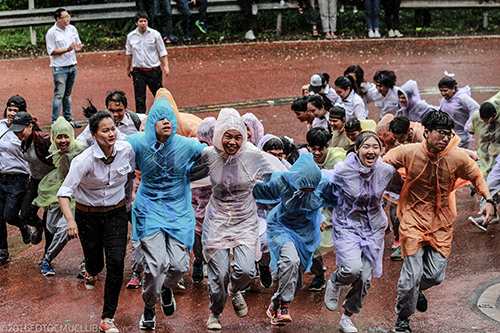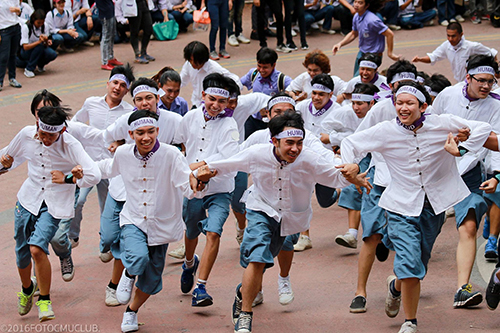Transportation to the future (photograph from CMU book 07)
This image, fondly named ‘Transportation to the Future’, depicts the first train heading north carrying the first group of students from Bangkok to Chiang Mai University. The train arrived in Chiang Mai on the 9th June 1964.
This image has deep meaning not just for the thousands of students and lecturers who have passed through the university, but also to the people of Chiang Mai, who had long been petitioning the government for a university.
Crowds gathered to greet the first arrival, turning the event into an annual tradition whereby students arriving from Bangkok would be greeted by the people of Chiang Mai.
This tradition, in fact, was started even before the formation of Chiang Mai University, being a tradition of the medical school of Chiang Mai, founded in 1956, which was later absorbed into the university as the Faculty of Medicine, Nakhon Chiang Mai Hospital in the year that the university was founded.
The medical school started the tradition on the 31st December 1960, when many turned up to greet the first graduating class of students at the train station on their arrival. Professor Emeritus Dr. Montreal Kantabutra provided the following information to the public in the Chiang Mai University Alumni Magazine, issue 5;
“The first event to greet new students was on the 31st December 1960 because the first group of students (graduating class 01) were already in their third year of studying medicine in Bangkok. They had but one more course to complete, and that was physiology which was to be studied at Chiang Mai. Before the class’s train arrived, large crowds gathered at the train station to greet them, following decades of lobbying the government for a university in the northern city. Multiple vehicles of all types carrying welcome signs turned up to pick up the students.”
“There were no motorcycles then, students riding bicycles instead and all first year medical students were known to ride bicycles for at least the first five years.”
Tradition of receiving students at the train station in 1964, the first year motorcycles were used to
pick up students. (Photograph from Chiang Mai University Alumni Magazine)
The first two years saw people gather to greet students at the train station, but there were no festivities until the third year when drums were played, garlands of jasmine were gifted and students were transported by bus to a shrine to pay their respects. They were then taken on a tour to visit various faculties and dormitories. However, the Students’ Association of Chiang Mai University began to hold more formal greetings of the newly arrived students around 1969, the tradition gaining traction and developing into what is today’s annual activities held for first year students.
Atmosphere at Hua Lamphong Station, Bangkok when the first group of students gathered for departure to Chiang Mai (1964)
Each year, students arriving from Bangkok would gather at Hua Lamphong Train Station, all arrangements made by Chiang Mai University, who had representatives there to greet them. Students wishing to participate would inform the university in advance and once aboard the train there would be multiple activities from learning the university’s theme song, faculty songs as well as cheering slogans of each faculty. Along the way, as the train stopped in Lopburi, Nakorn Sawan, Pitsanuloke and Lampang, where graduates of the university would stand at the platforms to greet the new ‘Baby Elephants’ as they headed further and further north towards their new home.
Greetings at the train station
(photograph from the university’s photography club)
This beautiful tradition showed the spirit of ‘Baby Elephants’, as those who had passed through the university stood in solidarity and encouragement of the many young students, mostly leaving home for the first time, as they entered a new stage of their lives.
This black and white image may, at first glance, appear to be from any of the dozens of events whereby new ‘Baby Elephants’ walked up Doi Suthep mountain as an annual tradition. However, according to Associate Professor Dr. Boonlom Cheva-Isarakul, Deputy Dean of Research, Faculty of Agriculture, Chiang Mai University (code 088003) in the book commemorating the faculty’s 50th anniversary;
“The first student to walk up to the top of Doi Suthep in this annual tradition was a girl from the Faculty of Agriculture. This photograph was taken as evidence (in 1965).”
Over the years, thousands of new students have made the long and challenging walk up the mountain, wending their way through verdant jungles, offering glimpses of spectacular vistas of the city below, to arrive at the sacred Wat Phra That Doi Suthep. For these students, this is an indelible memory, cherished for their rest of their lives.
Being a new university, traditions had to be created and maintained. It was therefore the brainchild of Professor Dr. Boonsom Martin, Vice President tasked with the welfare of students at the time, who created the Walk up Doi Suthep tradition.
“I wanted Chiang Mai University students to have a tradition unlike any other, something unique, memorable and that they can be proud of.”
Professor Dr. Boonsom Martin and students CMU code 07
from a book celebrating the first decade of the university
 Photos from the first group of students to walk up Doi Suthep in 1964
Photos from the first group of students to walk up Doi Suthep in 1964
Following student orientation, Professor Dr. Boonsom Martin invited all new students to follow the well trodden road up the mountain, a sacred route long respected by the people of Lanna. This road, built with the blood, sweat, finances and faith of hundreds of thousands of people of Chiang Mai, took a mere five and a half months to complete. Students arriving at the temple at the top of the mountain would pay their respects and ask for blessings; once complete they would be considered as a complete student of the university.
Kruba Srivichai, a saint for the people of Lanna who forged the way for the road
to be built up to Doi Suthep
Students praying to Wat Phra That Doi Suthep in 1971
Following the 1964 success of the tradition, when over 200 students participated in the walk, the university made the decision to adopt this tradition, which has since been held annually. Today, the tradition is renowned for its creativity, followed by citizens from across Thailand each year as the media always covers the event. Today tens of thousands participate annually, showing the strength, the spirit and the creativity of the students of Chiang Mai University – then and now.
The walk up the mountain is held on the first or second Saturday of the month following the start of the first term of the year. This traditionally falls on July of each year, allowing for some time for seniors, staff and those involved to prepare for the event at the start of the term. Seniors will often hold events to strengthen their young students physically as well as with song and team spirit building activities. On the day of the walk, students gather at Sala Dhamma to receive words of wisdom from the president of the university before walking to Kruba Srivichai Monument to pay respect to the monk who forged the way for the road up to Wat Phra That Doi Suthep. Then, faculty by faculty, the young student body would slowly ascend the mountain.

Following the long climb, there is one final challenge – the Khunkanchananon curve. One of the final curves in the road to Wat Phra That Doi Suthep is the sheerest and most challenging. Named after Khunkanchananon, a nobleman tasked with the completion of the final stretch of the road to the temple in 1935, this curve has become synonymous with the spirit of ‘Baby Elephants’. Gathering what remaining strength they have, students will hold onto one another, push, pull and encourage each other to conquer the turn, arrive at the temple, and circle the pagoda three times for blessings.

 The final curve
The final curve
The walk up Doi Suthep is more than a tradition, a custom, a part of the university culture. It is designed to build spirit. Students bond with one another, learn to follow leadership, understand their responsibilities, connect and gain compassion through adversity, forge friendships and remember this experience for a lifetime.